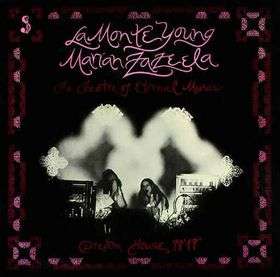Dream House 78' 17"
| Dream House 78' 17" | ||||
|---|---|---|---|---|
 | ||||
| Studio album by La Monte Young and Marian Zazeela | ||||
| Released | 1974 | |||
| Recorded | 1974 | |||
| Genre | Minimalist music, drone | |||
| Length | 78:17 | |||
| Label | Shandar | |||
| La Monte Young and Marian Zazeela chronology | ||||
| ||||
Originally released by the French label Shandar with the catalog number Shandar 83.510 and never re-released on CD, Dream House 78' 17" is one of the very few recordings ever made by minimalist composer La Monte Young, in this case together with his long-time companion Marian Zazeela and his group the Theatre of Eternal Music. The 78' 17" in the title consists of the duration of the record measured in minutes and seconds. This length, almost double what was then normal, was extremely unusual in its time. Young in the sleeve notes says that "Time is so important to the experiencing and understanding of the music in the record that every effort was made to make the record last as much as the original master tapes". Young thanks Mr. Michel Blancvillain who made it technically possible.
Cover, labels, design and calligraphy are by Marian Zazeela, and are drawn in her trademark magenta on a black background.
The two inner sides of the record jacket contain a comment by Shandar founder Daniel Caux, plus extensive original notes penned by La Monte Young himself about the music, its structure and its history. In 2016 Aguirre Records reissued the album on vinyl in a limited-edition, remasted form.[1]
Track listing
Side one
- "13 I 73 5:35 - 6:14:03 PM NYC" - 39:03
Personnel: Theatre of Eternal Music
- La Monte Young - Voice and Sine Waves
- Marian Zazeela - Voice
- Jon Hassell - Trumpet
- Garrett List - Trombone
Side two
- "Drift Study 14 VII 73 9:27:27-10:06:41 PM NYC" - 39:14
Three sine waves.
The titles of the two compositions consist of the date, time and place of the recording.
Sleeve notes synopsis
By 1963 La Monte Young had formulated the concept of a Dream House, a term which appears in the album title and which defines an artistic "work that would be played continuously and ultimately exist as a 'living organism with a life and tradition of its own'".
The Shandar record includes the music for one of Young's Dream Houses.
Young's first continuous electronic sound environment was created in his loft on Church Street, NYC in September 1966 (where he still lives and where the Dream House still exists) with sine wave generators. This environment was maintained almost continuously from September 1966 to January 1970, being turned off only to listen to "other music" and to study the contrast between extended periods in it and periods of silence. Young and Zazeela worked, sang and lived in it and studied the effects on themselves and visitors.
In July 1970 a model short-term Dream House was displayed to the public at Galerie Heiner Friedrich in Munich, Germany. Later, model Dream Houses were presented in various locations of Europe and the United States.
The work presented within these Dream Houses consisted of a "total environmental set of frequency structures in the media of sound and light". The sound was produced by both the sine wave generators and by the Theatre of Eternal Music, this last playing at prescribed intervals.
Zazeela designed two light sources to produce the frequencies in the light medium: a continuous installation of floating sculptures and color sources, and a series of slides entitled "Ornamental Lightyears Tracery".
The first composition, "Drift Study 14 VII 73 9:27:27-10:06:41 PM NYC" is a part of "Map of 49's Dream The Two Systems of Eleven Sets of Galactic Intervals Ornamental Lightyears Tracery", itself a section of an even longer work called "The Tortoise, His Dreams and Journeys". In it, three sine waves and the members of The Theatre of Eternal Music play together. According to Young, the lack of harmonic content of the sine waves makes accompanying them with regular instruments and human players extremely difficult.
The second composition, "Drift Study 14 VII 73 9:27:27-10:06:41 PM NYC (39" 14")", is played entirely by sine wave generators. Frequencies and voltages of the sine waves generators were determined and tuned by La Monte Young using oscillators custom-designed by sound engineer Robert Adler to generate specific frequencies and voltages of great stability. The sine waves produced are such that they interfere with each other, creating changes of volume both in time and space that can be experienced either walking within the room or staying put. If one chooses to walk, he will change the sound experience of other people in the room by moving the molecules of air.
A Dream House exists at the Mela Foundation on 275 Church Street, New York, and is open to the public.
Further reading
- Original Shandar album cover / sleeve notes
References
External links
- The Dream House
- Mela Foundation
- 2003 Interview of Zazeela and La Monte Young by Frank Oteri on Dream Houses
- Photos of Marian Zazeela light performance for a performance of cellist Charles Curtis